Ultrafast-Enhanced Silver Mirrors for 750 - 1000 nm

- Silver Coating Optimized for Femtosecond Ti:Sapphire Lasers
- >98.5% Reflectance for 750 - 1000 nm
- Low Group Delay Dispersion
PFD10-03-AG
Ø1" D-Shaped Mirror
Application Idea
HRS1015-AG Mounted Using a
KM100PM Kinematic Prism Mount and
PM4 Clamping Arm
HRS1015-AG
1" Retroreflecting
Hollow Roof Prism
HRS1015-AG
1" Retroreflecting
Hollow Roof Prism Mirror
HR1015-AG
Ø1" Mounted Retroreflecting
Hollow Roof Prism Mirror
UME1-AG
1'' Elliptical Mirror
UM20-AG
Ø2" Round Mirror

Please Wait
| Common Specifications | ||
|---|---|---|
| Wavelength Range | 750 - 1000 nm | |
| Reflectance (Click for Graph)a | Rs > 99.0%, and Rp > 98.5% | |
| Group Delay Dispersion |
Round, Elliptical, & D-Shaped Mirrors |
S-Pol: |GDD| < 20 fs2, P-Pol: |GDD| < 30 fs2 |
| Roof Prisms | S-Pol: |GDD| < 40 fs2, P-Pol: |GDD| < 60 fs2 | |
| Angle of Incidence | 45° Relative to Coated Face | |
| Laser Induced Damage Thresholdb | 0.39 J/cm2 (800 nm, 52 fs FWHM, S-Pol, 1 Pulse) 0.18 J/cm2 (800 nm, 52 fs FWHM, S-Pol, 1000 Pulses) |
|
Features
- Designed for 750 - 1000 nm
- High Reflectance
- >99.0% for S-Polarized Light (Per Surface)
- >98.5% for P-Polarized Light (Per Surface)
- Low Group Delay Dispersion (See Table to the Right)
- Round Mirrors, Elliptical Mirror, D-Shaped Mirrors, or Retroreflecting Hollow Roof Prism Mirrors
- Ø1" Round Mirrors Offered in Packs of 10
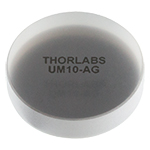
Click to Enlarge
The round and elliptical mirrors are laser engraved with their part numbers for easy identification.
Thorlabs' Ultrafast-Enhanced Silver Mirrors are designed for applications in the fundamental wavelength range of femtosecond Ti:Sapphire lasers. These mirrors are manufactured with a dielectric overcoat, provide >98.5% absolute reflectance over the 750 - 1000 nm wavelength range, and largely retain the low group delay dispersion (GDD) intrinsic to metallic coatings (see the tables below and the Graphs tab for details). We offer Ø1/2", Ø1", and Ø2" round mirrors, a 1'' elliptical mirror, Ø1/2" and Ø1" D-shaped mirrors, and 1" x 1" unmounted and Ø1" mounted retroreflecting hollow roof prism mirrors with this coating. The Ø1" round mirrors are also available in packs of 10.
For Thorlabs' full selection of optics for ultrafast applications, please see the Ultrafast Optics tab.
| Metal-Coated Plano Mirrors Selection Guide | ||||
|---|---|---|---|---|
Wavelength Range |
Reflectance
|
Coating |
Suffix |
Coating Comparison |
| 250 nm - 450 nm | Ravg > 90% | UV Enhanced Aluminum | -F01 | Raw Data |
| 450 nm - 20 μm | Ravg > 90% for 450 nm - 2 µm Ravg > 95% for 2 - 20 µm |
Protected Aluminum | -G01 | |
| 750 nm - 1 µm | Rs > 99.0% RP > 98.5% |
Ultrafast-Enhanced Silver | -AG | Raw Data |
| 450 nm - 20 μm | Ravg > 97.5% for 450 nm - 2 µm Ravg > 96% for 2 - 20 µm |
Protected Silver | -P01 | |
| Ravg > 97% for 450 nm - 2 µm Ravg > 95% for 2 - 20 µm |
Protected Silvera | -P02 | ||
| 800 nm - 20 μm | Ravg >96% | Protected Gold | -M01 | Raw Data |
| 2 µm - 20 µm | Ravg > 98% | MIR Enhanced Gold | -M02 | |
| 800 nm - 20 μm | Ravg > 97% | Unprotected Gold | -M03 | |
| 10.6 µm Laser Line | R > 99% | Unprotected Gold | -L01 | |
| Metal-Coated Zerodur® Mirrors | ||||
| Economy Front Surface Mirrors with Protected Metallic Coatings | ||||
The graph on the left shows the measured reflectance of our ultrafast-enhanced silver coating as a function of wavelength, while the graph on the right shows the theoretically calculated group delay dispersion (GDD) for a single surface. The shaded regions denote the wavelength range over which we guarantee the mirrors will meet the specifications listed in the Overview tab. Performance outside the shaded regions will vary from lot to lot and is not guaranteed.
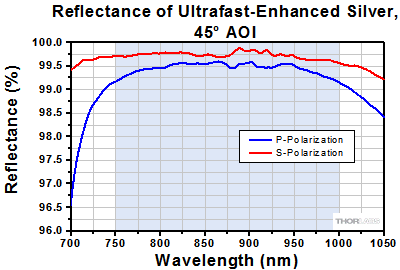
Click to Enlarge
Click for Raw Data from 649 - 1075 nm
Measured Reflectance of Our Ultrafast-Enhanced Silver
Coating as a Function of Wavelength
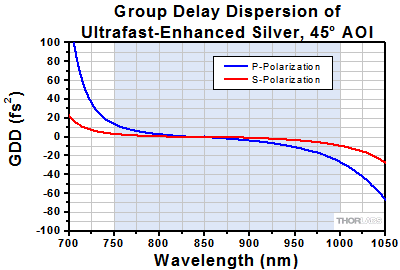
Click to Enlarge
Click for Raw Data from 649 - 1075 nm
Theoretically Calculated Group Delay Dispersion (GDD) for a Single Surface
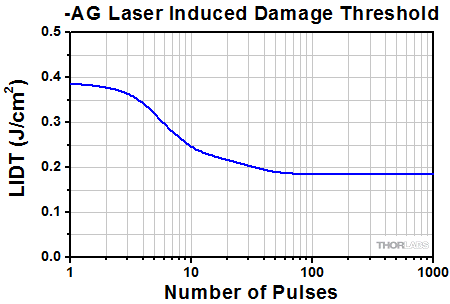
Click to Enlarge
The laser induced damage threshold (LIDT) value of an ultrafast optic is defined as the fluence (per pulse) that produces visible damage after a given number of pulses. These LIDT values were measured with 52 fs FWHM pulses at 800 nm that were s-polarized and incident at 45°.
This tab compares Thorlabs' mirror coatings recommended for the Ti:sapphire wavelength range: our 720 - 900 nm low-GDD dielectric with 0° angle of incidence (AOI), our 700 - 930 nm low-GDD dielectric with 45° AOI, our ultrafast-enhanced silver, our standard protected silver, and our broadband dielectric -E02 coatings.
Qualitative Comparison
Our Low-GDD Dielectric Coatings and Ultrafast-Enhanced Silver Coating are specifically designed for femtosecond Ti:sapphire lasers. The low-GDD dielectric coatings provide the highest reflectance, making them suitable for laser cavities, while the ultrafast-enhanced silver coating provides slightly lower reflectance and a slightly broader wavelength range. Each offers low group delay dispersion of |GDD| < 30 fs2 or better.
The Protected Silver Coatings offer the widest spectral range and minimal dependence on the angle of incidence. However, their reflectance at typical Ti:sapphire wavelengths is somewhat lower than our low-GDD dielectric and ultrafast-enhanced silver coatings, and the GDD is not specified.
Our -E02 Broadband Dielectric Mirror Coating has resonance structures within the dielectric coating layers. These structures cause ripples in the group delay dispersion and can furthermore vary strongly between coating runs. While these variations do not impact CW performance, when an ultrafast laser pulse hits such a mirror, the pulse is strongly distorted. Thorlabs' low-GDD dielectric coatings and the dielectric overcoat on our ultrafast-enhanced silver mirrors are designed in such a way that there is no resonance inside the layers, thereby maintaining smooth dispersion and reflectance across the design wavelength range.
Specs Comparison
The table below summarizes the reflectance, spectral range, and group delay dispersion of the different coatings.
| Mirror Coating | Item # Suffix | Angle of Incidence | Spectral Range | Reflectance | Group Delay Dispersion | ||
|---|---|---|---|---|---|---|---|
| Low-GDD Dielectric Coatings | -0A | 0° | 720 - 900 nm | R > 99% | |GDD| < 30 fs2 | ||
| -45A | 45° | S-Pol: 700 - 930 nm P-Pol: 730 - 870 nm |
Rs > 99% Rp > 99% |
S-Pol: |GDD| < 30 fs2 P-Pol: |GDD| < 30 fs2 |
|||
| Ultrafast-Enhanced Silver Coating | -AG | 45° | 750 - 1000 nm | Rs > 99.0% Rp > 98.5% |
S-Pol: |GDD| < 20 fs2 P-Pol: |GDD| < 30 fs2 |
||
| Protected Silver Coatings | -P01 | 0° - 45° | 450 nm - 20 µm | Ravg > 97.5% for 450 nm - 2 µm Ravg > 96% for 2 - 20 µm |
Not Specifieda,b | - | |
| -P02 | 0° - 45° | Ravg > 97% for 450 nm - 2 µm Ravg > 95% for 2 - 20 µm |
Not Specifieda,b | - | |||
| Broadband Dielectric Coating | -E02 | 0° - 45° | 400 - 750 nm | Ravg > 99% | Not Specifiedb | - | |
| Damage Threshold Specifications | |
|---|---|
| Coating Designation (Item # Suffix) |
Damage Thresholda |
| -AG | 0.39 J/cm2 (800 nm, 52 fs FWHM, S-Pol, 1 Pulse) 0.18 J/cm2 (800 nm, 52 fs FWHM, S-Pol, 1000 Pulses) |
Damage Threshold Data for Thorlabs' Ultrafast-Enhanced Silver Mirrors
The specifications to the right are measured data for Thorlabs' ultrafast-enhanced silver mirrors. Damage threshold specifications are constant for these mirrors, regardless of the size.
Laser Induced Damage Threshold Tutorial
The following is a general overview of how laser induced damage thresholds are measured and how the values may be utilized in determining the appropriateness of an optic for a given application. When choosing optics, it is important to understand the Laser Induced Damage Threshold (LIDT) of the optics being used. The LIDT for an optic greatly depends on the type of laser you are using. Continuous wave (CW) lasers typically cause damage from thermal effects (absorption either in the coating or in the substrate). Pulsed lasers, on the other hand, often strip electrons from the lattice structure of an optic before causing thermal damage. Note that the guideline presented here assumes room temperature operation and optics in new condition (i.e., within scratch-dig spec, surface free of contamination, etc.). Because dust or other particles on the surface of an optic can cause damage at lower thresholds, we recommend keeping surfaces clean and free of debris. For more information on cleaning optics, please see our Optics Cleaning tutorial.
Testing Method
Thorlabs' LIDT testing is done in compliance with ISO/DIS 11254 and ISO 21254 specifications.
First, a low-power/energy beam is directed to the optic under test. The optic is exposed in 10 locations to this laser beam for 30 seconds (CW) or for a number of pulses (pulse repetition frequency specified). After exposure, the optic is examined by a microscope (~100X magnification) for any visible damage. The number of locations that are damaged at a particular power/energy level is recorded. Next, the power/energy is either increased or decreased and the optic is exposed at 10 new locations. This process is repeated until damage is observed. The damage threshold is then assigned to be the highest power/energy that the optic can withstand without causing damage. A histogram such as that below represents the testing of one BB1-E02 mirror.

The photograph above is a protected aluminum-coated mirror after LIDT testing. In this particular test, it handled 0.43 J/cm2 (1064 nm, 10 ns pulse, 10 Hz, Ø1.000 mm) before damage.

| Example Test Data | |||
|---|---|---|---|
| Fluence | # of Tested Locations | Locations with Damage | Locations Without Damage |
| 1.50 J/cm2 | 10 | 0 | 10 |
| 1.75 J/cm2 | 10 | 0 | 10 |
| 2.00 J/cm2 | 10 | 0 | 10 |
| 2.25 J/cm2 | 10 | 1 | 9 |
| 3.00 J/cm2 | 10 | 1 | 9 |
| 5.00 J/cm2 | 10 | 9 | 1 |
According to the test, the damage threshold of the mirror was 2.00 J/cm2 (532 nm, 10 ns pulse, 10 Hz, Ø0.803 mm). Please keep in mind that these tests are performed on clean optics, as dirt and contamination can significantly lower the damage threshold of a component. While the test results are only representative of one coating run, Thorlabs specifies damage threshold values that account for coating variances.
Continuous Wave and Long-Pulse Lasers
When an optic is damaged by a continuous wave (CW) laser, it is usually due to the melting of the surface as a result of absorbing the laser's energy or damage to the optical coating (antireflection) [1]. Pulsed lasers with pulse lengths longer than 1 µs can be treated as CW lasers for LIDT discussions.
When pulse lengths are between 1 ns and 1 µs, laser-induced damage can occur either because of absorption or a dielectric breakdown (therefore, a user must check both CW and pulsed LIDT). Absorption is either due to an intrinsic property of the optic or due to surface irregularities; thus LIDT values are only valid for optics meeting or exceeding the surface quality specifications given by a manufacturer. While many optics can handle high power CW lasers, cemented (e.g., achromatic doublets) or highly absorptive (e.g., ND filters) optics tend to have lower CW damage thresholds. These lower thresholds are due to absorption or scattering in the cement or metal coating.

LIDT in linear power density vs. pulse length and spot size. For long pulses to CW, linear power density becomes a constant with spot size. This graph was obtained from [1].

Pulsed lasers with high pulse repetition frequencies (PRF) may behave similarly to CW beams. Unfortunately, this is highly dependent on factors such as absorption and thermal diffusivity, so there is no reliable method for determining when a high PRF laser will damage an optic due to thermal effects. For beams with a high PRF both the average and peak powers must be compared to the equivalent CW power. Additionally, for highly transparent materials, there is little to no drop in the LIDT with increasing PRF.
In order to use the specified CW damage threshold of an optic, it is necessary to know the following:
- Wavelength of your laser
- Beam diameter of your beam (1/e2)
- Approximate intensity profile of your beam (e.g., Gaussian)
- Linear power density of your beam (total power divided by 1/e2 beam diameter)
Thorlabs expresses LIDT for CW lasers as a linear power density measured in W/cm. In this regime, the LIDT given as a linear power density can be applied to any beam diameter; one does not need to compute an adjusted LIDT to adjust for changes in spot size, as demonstrated by the graph to the right. Average linear power density can be calculated using the equation below.

The calculation above assumes a uniform beam intensity profile. You must now consider hotspots in the beam or other non-uniform intensity profiles and roughly calculate a maximum power density. For reference, a Gaussian beam typically has a maximum power density that is twice that of the uniform beam (see lower right).
Now compare the maximum power density to that which is specified as the LIDT for the optic. If the optic was tested at a wavelength other than your operating wavelength, the damage threshold must be scaled appropriately. A good rule of thumb is that the damage threshold has a linear relationship with wavelength such that as you move to shorter wavelengths, the damage threshold decreases (i.e., a LIDT of 10 W/cm at 1310 nm scales to 5 W/cm at 655 nm):

While this rule of thumb provides a general trend, it is not a quantitative analysis of LIDT vs wavelength. In CW applications, for instance, damage scales more strongly with absorption in the coating and substrate, which does not necessarily scale well with wavelength. While the above procedure provides a good rule of thumb for LIDT values, please contact Tech Support if your wavelength is different from the specified LIDT wavelength. If your power density is less than the adjusted LIDT of the optic, then the optic should work for your application.
Please note that we have a buffer built in between the specified damage thresholds online and the tests which we have done, which accommodates variation between batches. Upon request, we can provide individual test information and a testing certificate. The damage analysis will be carried out on a similar optic (customer's optic will not be damaged). Testing may result in additional costs or lead times. Contact Tech Support for more information.
Pulsed Lasers
As previously stated, pulsed lasers typically induce a different type of damage to the optic than CW lasers. Pulsed lasers often do not heat the optic enough to damage it; instead, pulsed lasers produce strong electric fields capable of inducing dielectric breakdown in the material. Unfortunately, it can be very difficult to compare the LIDT specification of an optic to your laser. There are multiple regimes in which a pulsed laser can damage an optic and this is based on the laser's pulse length. The highlighted columns in the table below outline the relevant pulse lengths for our specified LIDT values.
Pulses shorter than 10-9 s cannot be compared to our specified LIDT values with much reliability. In this ultra-short-pulse regime various mechanics, such as multiphoton-avalanche ionization, take over as the predominate damage mechanism [2]. In contrast, pulses between 10-7 s and 10-4 s may cause damage to an optic either because of dielectric breakdown or thermal effects. This means that both CW and pulsed damage thresholds must be compared to the laser beam to determine whether the optic is suitable for your application.
| Pulse Duration | t < 10-9 s | 10-9 < t < 10-7 s | 10-7 < t < 10-4 s | t > 10-4 s |
|---|---|---|---|---|
| Damage Mechanism | Avalanche Ionization | Dielectric Breakdown | Dielectric Breakdown or Thermal | Thermal |
| Relevant Damage Specification | No Comparison (See Above) | Pulsed | Pulsed and CW | CW |
When comparing an LIDT specified for a pulsed laser to your laser, it is essential to know the following:

LIDT in energy density vs. pulse length and spot size. For short pulses, energy density becomes a constant with spot size. This graph was obtained from [1].
- Wavelength of your laser
- Energy density of your beam (total energy divided by 1/e2 area)
- Pulse length of your laser
- Pulse repetition frequency (prf) of your laser
- Beam diameter of your laser (1/e2 )
- Approximate intensity profile of your beam (e.g., Gaussian)
The energy density of your beam should be calculated in terms of J/cm2. The graph to the right shows why expressing the LIDT as an energy density provides the best metric for short pulse sources. In this regime, the LIDT given as an energy density can be applied to any beam diameter; one does not need to compute an adjusted LIDT to adjust for changes in spot size. This calculation assumes a uniform beam intensity profile. You must now adjust this energy density to account for hotspots or other nonuniform intensity profiles and roughly calculate a maximum energy density. For reference a Gaussian beam typically has a maximum energy density that is twice that of the 1/e2 beam.
Now compare the maximum energy density to that which is specified as the LIDT for the optic. If the optic was tested at a wavelength other than your operating wavelength, the damage threshold must be scaled appropriately [3]. A good rule of thumb is that the damage threshold has an inverse square root relationship with wavelength such that as you move to shorter wavelengths, the damage threshold decreases (i.e., a LIDT of 1 J/cm2 at 1064 nm scales to 0.7 J/cm2 at 532 nm):

You now have a wavelength-adjusted energy density, which you will use in the following step.
Beam diameter is also important to know when comparing damage thresholds. While the LIDT, when expressed in units of J/cm², scales independently of spot size; large beam sizes are more likely to illuminate a larger number of defects which can lead to greater variances in the LIDT [4]. For data presented here, a <1 mm beam size was used to measure the LIDT. For beams sizes greater than 5 mm, the LIDT (J/cm2) will not scale independently of beam diameter due to the larger size beam exposing more defects.
The pulse length must now be compensated for. The longer the pulse duration, the more energy the optic can handle. For pulse widths between 1 - 100 ns, an approximation is as follows:

Use this formula to calculate the Adjusted LIDT for an optic based on your pulse length. If your maximum energy density is less than this adjusted LIDT maximum energy density, then the optic should be suitable for your application. Keep in mind that this calculation is only used for pulses between 10-9 s and 10-7 s. For pulses between 10-7 s and 10-4 s, the CW LIDT must also be checked before deeming the optic appropriate for your application.
Please note that we have a buffer built in between the specified damage thresholds online and the tests which we have done, which accommodates variation between batches. Upon request, we can provide individual test information and a testing certificate. Contact Tech Support for more information.
[1] R. M. Wood, Optics and Laser Tech. 29, 517 (1998).
[2] Roger M. Wood, Laser-Induced Damage of Optical Materials (Institute of Physics Publishing, Philadelphia, PA, 2003).
[3] C. W. Carr et al., Phys. Rev. Lett. 91, 127402 (2003).
[4] N. Bloembergen, Appl. Opt. 12, 661 (1973).
In order to illustrate the process of determining whether a given laser system will damage an optic, a number of example calculations of laser induced damage threshold are given below. For assistance with performing similar calculations, we provide a spreadsheet calculator that can be downloaded by clicking the button to the right. To use the calculator, enter the specified LIDT value of the optic under consideration and the relevant parameters of your laser system in the green boxes. The spreadsheet will then calculate a linear power density for CW and pulsed systems, as well as an energy density value for pulsed systems. These values are used to calculate adjusted, scaled LIDT values for the optics based on accepted scaling laws. This calculator assumes a Gaussian beam profile, so a correction factor must be introduced for other beam shapes (uniform, etc.). The LIDT scaling laws are determined from empirical relationships; their accuracy is not guaranteed. Remember that absorption by optics or coatings can significantly reduce LIDT in some spectral regions. These LIDT values are not valid for ultrashort pulses less than one nanosecond in duration.

A Gaussian beam profile has about twice the maximum intensity of a uniform beam profile.
CW Laser Example
Suppose that a CW laser system at 1319 nm produces a 0.5 W Gaussian beam that has a 1/e2 diameter of 10 mm. A naive calculation of the average linear power density of this beam would yield a value of 0.5 W/cm, given by the total power divided by the beam diameter:

However, the maximum power density of a Gaussian beam is about twice the maximum power density of a uniform beam, as shown in the graph to the right. Therefore, a more accurate determination of the maximum linear power density of the system is 1 W/cm.
An AC127-030-C achromatic doublet lens has a specified CW LIDT of 350 W/cm, as tested at 1550 nm. CW damage threshold values typically scale directly with the wavelength of the laser source, so this yields an adjusted LIDT value:

The adjusted LIDT value of 350 W/cm x (1319 nm / 1550 nm) = 298 W/cm is significantly higher than the calculated maximum linear power density of the laser system, so it would be safe to use this doublet lens for this application.
Pulsed Nanosecond Laser Example: Scaling for Different Pulse Durations
Suppose that a pulsed Nd:YAG laser system is frequency tripled to produce a 10 Hz output, consisting of 2 ns output pulses at 355 nm, each with 1 J of energy, in a Gaussian beam with a 1.9 cm beam diameter (1/e2). The average energy density of each pulse is found by dividing the pulse energy by the beam area:

As described above, the maximum energy density of a Gaussian beam is about twice the average energy density. So, the maximum energy density of this beam is ~0.7 J/cm2.
The energy density of the beam can be compared to the LIDT values of 1 J/cm2 and 3.5 J/cm2 for a BB1-E01 broadband dielectric mirror and an NB1-K08 Nd:YAG laser line mirror, respectively. Both of these LIDT values, while measured at 355 nm, were determined with a 10 ns pulsed laser at 10 Hz. Therefore, an adjustment must be applied for the shorter pulse duration of the system under consideration. As described on the previous tab, LIDT values in the nanosecond pulse regime scale with the square root of the laser pulse duration:

This adjustment factor results in LIDT values of 0.45 J/cm2 for the BB1-E01 broadband mirror and 1.6 J/cm2 for the Nd:YAG laser line mirror, which are to be compared with the 0.7 J/cm2 maximum energy density of the beam. While the broadband mirror would likely be damaged by the laser, the more specialized laser line mirror is appropriate for use with this system.
Pulsed Nanosecond Laser Example: Scaling for Different Wavelengths
Suppose that a pulsed laser system emits 10 ns pulses at 2.5 Hz, each with 100 mJ of energy at 1064 nm in a 16 mm diameter beam (1/e2) that must be attenuated with a neutral density filter. For a Gaussian output, these specifications result in a maximum energy density of 0.1 J/cm2. The damage threshold of an NDUV10A Ø25 mm, OD 1.0, reflective neutral density filter is 0.05 J/cm2 for 10 ns pulses at 355 nm, while the damage threshold of the similar NE10A absorptive filter is 10 J/cm2 for 10 ns pulses at 532 nm. As described on the previous tab, the LIDT value of an optic scales with the square root of the wavelength in the nanosecond pulse regime:

This scaling gives adjusted LIDT values of 0.08 J/cm2 for the reflective filter and 14 J/cm2 for the absorptive filter. In this case, the absorptive filter is the best choice in order to avoid optical damage.
Pulsed Microsecond Laser Example
Consider a laser system that produces 1 µs pulses, each containing 150 µJ of energy at a repetition rate of 50 kHz, resulting in a relatively high duty cycle of 5%. This system falls somewhere between the regimes of CW and pulsed laser induced damage, and could potentially damage an optic by mechanisms associated with either regime. As a result, both CW and pulsed LIDT values must be compared to the properties of the laser system to ensure safe operation.
If this relatively long-pulse laser emits a Gaussian 12.7 mm diameter beam (1/e2) at 980 nm, then the resulting output has a linear power density of 5.9 W/cm and an energy density of 1.2 x 10-4 J/cm2 per pulse. This can be compared to the LIDT values for a WPQ10E-980 polymer zero-order quarter-wave plate, which are 5 W/cm for CW radiation at 810 nm and 5 J/cm2 for a 10 ns pulse at 810 nm. As before, the CW LIDT of the optic scales linearly with the laser wavelength, resulting in an adjusted CW value of 6 W/cm at 980 nm. On the other hand, the pulsed LIDT scales with the square root of the laser wavelength and the square root of the pulse duration, resulting in an adjusted value of 55 J/cm2 for a 1 µs pulse at 980 nm. The pulsed LIDT of the optic is significantly greater than the energy density of the laser pulse, so individual pulses will not damage the wave plate. However, the large average linear power density of the laser system may cause thermal damage to the optic, much like a high-power CW beam.
| Posted Comments: | |
user
(posted 2024-05-08 14:38:27.263) Do you have any data (I know it would be for information purposes) on the reflectivity of these mirrors outside the shown range? Especially in the 550-650nm an 1400-1600nm range? I know the other protected silver mirrors also exist, but I have an application where the priority is 800nm, but I may also send some light in the above ranges, and I want to have a rough idea about how low the reflectivity would be there. Thanks! Gregor cdolbashian
(posted 2024-05-13 01:02:19.0) Thank you for reaching out to us with this inquiry. We do indeed have some test data to share, and I have contacted you directly to share such data. user
(posted 2020-10-30 19:23:38.077) How about adding a 2" or 50mm OD version? YLohia
(posted 2020-11-04 09:40:59.0) Thank you for your feedback. I have posted your request to our internal engineering forum for further consideration as a future catalog item. Alexander Jesacher
(posted 2019-11-25 09:58:24.133) We have a Ti-Sapph laser with pre-chirp compensation. (0-40000fs²)
In this case, do we really need ultrafast mirrors or can the Standard silver-mirrors be used as well?
Thanks! nbayconich
(posted 2019-11-27 01:18:45.0) Thank you for contacting Thorlabs. The standard -P01 protected silver coated mirrors will also have a low GDD value, however we recommend using the -AG coating as they will have a lower GDD value and have also been laser damage threshold tested for femtosecond pulsed sources. lzeldin
(posted 2018-01-29 16:38:52.65) What I do not see in your overview for ultra fast mirrors is the effect of a slightly different AOI from 0 or 45 degree AOI. Do you have such graphs?? tfrisch
(posted 2018-03-22 01:18:17.0) Hello, thank you for contacting Thorlabs. I can reach out to you with other typical data we have collected at angles of incidence other than the design 45 degrees. neilb
(posted 2017-12-01 11:38:11.03) How do these mirrors compare to protected silver mirrors in terms of tarnish resistance and abrasion resistance? Are there any considerations when cleaning these mirrors compared to protected silver mirrors? tfrisch
(posted 2017-12-12 01:48:05.0) Hello, thank you for contacting Thorlabs. These mirrors can be treated similarly to our standard protected silver mirrors. We use Acetone and Isopropyl here and have had no problems. For your reference we list some general cleaning procedures at the following link: https://www.thorlabs.us/newgrouppage9.cfm?objectgroup_id=9025 vaczi.tamas
(posted 2017-11-28 17:39:30.123) Do you recommend this mirror for 90 deg angle of incidence? If not, what is your suggestion for a low-GDD reflection of fs pulses? nbayconich
(posted 2017-12-19 03:08:35.0) Thank you for contacting Thorlabs. The enhanced silver coatings can be used at normal incidence but there will be a slight shift in the GDD as well as the reflectivity of the -AG coating. I will contact you directly with data on the performance of the -AG coating at different AOI's. j.travers
(posted 2016-09-10 17:06:00.977) Can you offer 2" versions? tfrisch
(posted 2016-09-15 10:15:46.0) Hello, we will contact you directly for information about this quote. cbrideau
(posted 2016-03-31 16:49:45.833) Can we purchase these in 10-packs like the regular protected silver mirrors? besembeson
(posted 2016-03-31 06:01:16.0) Response from Bweh at Thorlabs USA: Yes we can provide this in the box but it will not be at the same discounted price at the moment. We will review including this in packs as regular stock similar to the protected silver mirrors. There are also several empty boxes at the following link if that would be an interest: http://www.thorlabs.com/newgrouppage9.cfm?objectgroup_id=4132. cbrideau
(posted 2014-08-28 15:47:24.473) How does this silver coating stack up against gold coatings for the same wavelength range? besembeson
(posted 2014-09-04 08:43:59.0) Response from Bweh at Thorlabs: Silver coatings offer the highest reflectivity in the visible-NIR spectrum (> 98.5% average in the 750-1000 nm range) and have low group delay over the 0.45-20um range so they are more suitable for ultrafast applications compared to gold coatings that show an average reflectivity of about 96% in the 750-1000 nm range. I will followup by email regarding your application and your need for the gold coated mirrors. |
Thorlabs offers a wide selection of optics optimized for use with femtosecond and picosecond laser pulses. Please see below for more information.
| Low-GDD Mirrors | |||||
|---|---|---|---|---|---|
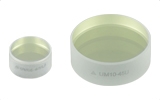 |
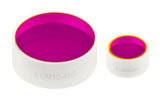 |
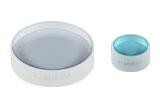 |
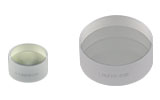 |
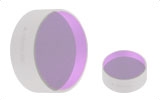 |
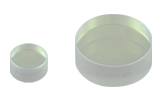 |
| 355 - 445 nm | 460 - 590 nm | 700 - 930 nm | 970 - 1150 nm | 1400 - 1700 nm | 1760 - 2250 nm |
| Dielectric Mirror | High-Power Mirrors for Picosecond Lasers |
Metallic Mirrors | Low-GDD Pump-Through Mirrors |
||
|---|---|---|---|---|---|
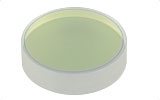 |
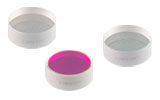 |
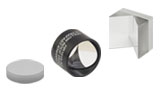 |
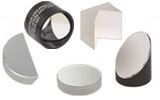 |
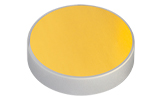 |
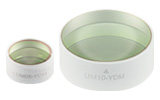 |
| Dual-Band Dielectric Mirror, 400 nm and 800 nm |
Ytterbium Laser Line Mirrors, 250 nm - 1080 nm |
Ultrafast-Enhanced Silver Mirrors, 750 - 1000 nm |
Protected Silver Mirrors, 450 nm - 20 µm |
Unprotected Gold Mirrors, 800 nm - 20 µm |
Pump-Through Mirrors, 1030 - 1080 nm and 940 - 980 nm |
| Deterministic GDD Beamsplitters |
Low-GDD Harmonic Beamsplitters |
Low-GDD Polarizing Beamsplitters |
β-BBO Crystals | Dispersion-Compensating Optics | |
|---|---|---|---|---|---|
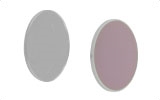 |
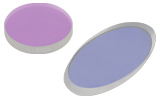 |
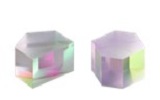 |
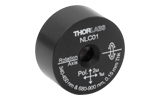 |
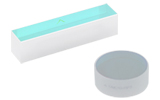 |
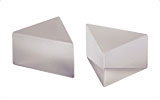 |
| Beamsplitters & Windows, 600 - 1500 nm or 1000 - 2000 nm |
Harmonic Beamsplitters, 400 nm and 800 nm or 500 nm and 1000 nm |
High-Power, Broadband, High Extinction Ratio Polarizers, 700 - 1300 nm | β-BBO Crystals for Second Harmonic Generation |
Dispersion-Compensating Mirrors, 650 - 1050 nm |
Dispersion-Compensating Prisms, 700 - 900 nm |

| Item # | UM05-AG | UM10-AG | UM20-AG |
|---|---|---|---|
| Diameter | 1/2" | 1" | 2" |
| Diameter Tolerance | +0.00 mm / -0.10 mm | ||
| Thickness | 6.0 mm | 6.0 mm | 12.0 mm |
| Thickness Tolerance | ±0.20 mm | ±0.20 mm | ±0.2 mm |
| Clear Aperture | >80% of Diameter | ||
| Group Delay Dispersion | S-Pol: |GDD| < 20 fs2 P-Pol: |GDD| < 30 fs2 |
||
| Front Surface Flatness (@ 632.8 nm, Peak to Valley) |
λ/20 | λ/10 | <λ/10 |
| Front Surface Quality | 40-20 Scratch-Dig | ||
| Back Surface | Fine Ground | ||
| Parallelism | ≤3 arcmin | ||
| Substrate | Fused Silica | ||
- Ø1/2", Ø1", or Ø2" Round Mirrors
- Polished and Coated Front Surface with Fine Ground Back Surface
- Ø1" Round Mirrors Offered in Packs of 10
Compared to our low-GDD dielectric mirrors for 700 - 930 nm, these enhanced silver mirrors offer similar GDD, a slightly wider reflectance range, and a slightly lower reflectance value. For a general comparison of the performance of our ultrafast-enhanced silver mirrors, standard protected silver mirrors, low-GDD dielectric mirrors, and broadband dielectric mirrors, please see the Mirror Comparison tab.
As shown by the image above, the fine-ground back surface of each mirror is engraved with its item # for easy identification.

| Item # | UME1-AG | |
|---|---|---|
| Minor Axis | 1" (25.4 mm) | |
| Major Axis | 1.41" (35.8 mm) | |
| Diameter Tolerance | +0.0/-0.1 mm | |
| Thickness | 6.0 mm | |
| Thickness Tolerance | ±0.2 mm | |
| Circular Clear Aperture | >Ø22.9 mm | |
| Group Delay Dispersion | S-Pol: |GDD| < 20 fs2 P-Pol: |GDD| < 30 fs2 |
|
| Surface Flatness |
λ/10 at 633 nm (Peak to Valley) | |
| Front Surface Quality | 40-20 Scratch-Dig | |
| Back Surface | Fine Ground | |
| Parallelism | <5 arcmin | |
| Substrate | Fused Silica | |
- 1" Elliptical Mirror that Provides a Ø1'' Aperture at 45° AOI
- Thickness: 6.0 mm
- Polished and Coated Front Surface with Fine Ground Back Surface
Thorlabs' ultrafast-enhanced silver mirror features a coated face on an elliptical fused silica substrate. When the mirror is rotated by 45° about the minor axis, the resulting clear aperture is circular.
Compared to our low-GDD dielectric mirrors for 700 - 930 nm, this enhanced silver mirror offers similar GDD, a slightly wider reflectance range, and a slightly lower reflectance value. For a general comparison of the performance of our ultrafast-enhanced silver mirrors, standard protected silver mirrors, low-GDD dielectric mirrors, and broadband dielectric mirrors, please see the Mirror Comparison tab.
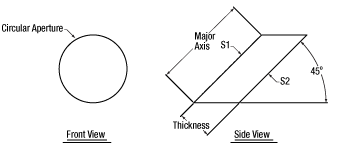
When elliptical mirrors are oriented at a 45° incident angle, the clear aperture is circular.
To mount this mirror, we suggest our Fixed 45° or Kinematic Elliptical Mirror Mounts. Our fixed 45° mounts are compatible with 1" elliptical mirrors. They can be post mounted or secured in an unthreaded, standard kinematic mirror mount.
For other metal-coated elliptical mirror options, please see our elliptical mirrors.

| Item # | PFD05-03-AG | PFD10-03-AG |
|---|---|---|
| Diameter | Ø1/2" | Ø1" |
| Diameter Tolerance | +0.0 mm / -0.1 mm | |
| Thickness | 6.0 mm | |
| Thickness Tolerance | ±0.2 mm | |
| Clear Aperture | >90% of Diameter | |
| Group Delay Dispersion (@ 45° AOI) |
S-Pol: |GDD| < 20 fs2 P-Pol: |GDD| < 30 fs2 |
|
| Front Surface Flatness (@ 632.8 nm, Peak to Valley) |
λ/10 | |
| Front Surface Quality | 40-20 Scratch-Dig | |
| Back Surface | Fine Grind | |
| Wedge | <5 arcmin | |
| Substrate | Fused Silica | |
| Damage Threshold (Pulse) | 0.18 J/cm2 (800 nm, 52 fs FWHM, S-Pol, 1000 Pulses) 0.39 J/cm2 (800 nm, 52 fs FWHM, S-Pol, Single Pulse) |
|
- Ø1/2" or Ø1" D-Shaped Mirrors
- Polished and Coated Front Surface with Fine Ground Back Surface
- Pickoff Mirrors for Femtosecond Lasers
Thorlabs' Ultrafast-Enhanced D-Shaped Silver Mirrors are designed for the separation of closely spaced beams. Each mirror is coated to 0.05 mm of its straight edge and has had a wedge of substrate removed to facilitate the pickoff of one beam without clipping the other.
A summary of these mirrors' specifications is given in the table to the right. For an in depth comparison of our ultrafast-enhanced silver mirrors, low-GDD dielectric mirrors for 730 nm - 930 nm, broadband dielectric mirrors, and standard protected silver mirrors, please see the Mirror Comparison tab.

| Item # | HRS1015-AG | HR1015-AG |
|---|---|---|
| Substrate Dimensions | 1.00" x 1.00" (25.4 mm x 25.4 mm) |
Ø0.89" (22.6 mm)a |
| Mirror Face Dimensions (2 Places) |
1.00" x 0.71" (25.4 mm x 18.03 mm) |
- |
| Click for Mechanical Drawing | ||
| Dihedral Angle Accuracy | ±10 arcsec | |
| Clear Apertureb | >80% of Face Dimensions | >Ø18.0 mm |
| Group Delay Dispersion | S-Pol: |GDD| < 40 fs2 P-Pol: |GDD| < 60 fs2 |
|
| Coated Surface Flatness (Peak to Valley) |
<λ/4 at 633 nm | |
| Coated Surface Quality | 40-20 Scratch-Dig | |
| Reflected Wavefront Error | <λ/2 at 633 nm (Peak to Valley) | |
| Substrate | UV Fused Silicac | |
- Hollow Roof Prism Acts as 180° Retroreflector
- Two Right-Angle Prism Mirrors with Reflective Coating on Hypotenuses
- Available Unmounted or in Ø1" Housing

Click to Enlarge
180° Reflection is Independent of the Incident Angle of the Incoming Light
The HRS1015-AG and HR1015-AG Ultrafast Enhanced, Hollow Roof Prism Mirrors are constructed using two UV fused silica right-angle prism mirrors that have an ultrafast-enhanced silver reflective coating on their hypotenuses. The resulting dihedral angle between the two coated surfaces is 90° ± 10 arcsec. Thorlabs also offers hollow roof prism mirrors with a variety of other coatings.
The unmounted HRS1015-AG mirror allows for simple positioning within an optical system, and can be mounted using a kinematic platform mount and clamping arm. The mirror in the HR1015-AG is premounted in a Ø1" unthreaded aluminum housing and can be mounted into Ø1" optical mounts or a threaded SM1 (1.035"-40) lens tube with the use of SM1RR retaining rings.
Designed to reflect light that is externally incident on the hypotenuse of the prisms, these hollow roof prism mirrors are ideal for use as a retroreflector in applications where refraction, chromatic aberrations, material absorption, or front surface reflections from standard prisms are undesirable. The 180° reflection of the light is independent of the incident angle of the incoming light, as illustrated in the image to the left.
 Products Home
Products Home














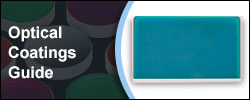
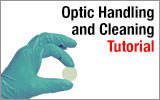

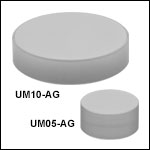
 Zoom
Zoom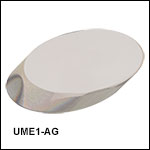
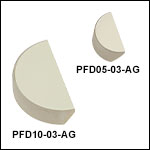
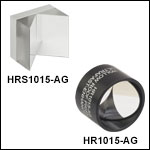
 Ultrafast-Enhanced Silver Mirrors, 750 - 1000 nm
Ultrafast-Enhanced Silver Mirrors, 750 - 1000 nm